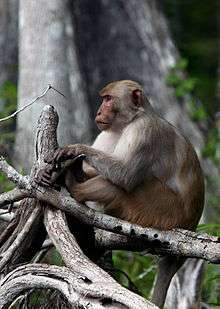Feral rhesus macaque
Feral rhesus macaques are wild troupes of the rhesus macaque released by researchers, zoos, or private owners, that have been able to survive and propagate in several places in the United States.
Puerto Rico
Cayo Santiago
A research colony was established by the Caribbean Primate Research Center of the University of Puerto Rico on the island of Cayo Santiago, off Puerto Rico. There are no predators on the island, and humans are not permitted to land, except as part of the research program.
Florida
Silver Springs State Park

A colony of rhesus macaques was established around Silver Springs in Florida around the spring of 1938. The monkeys were released by tour boat operator Colonel Tooey,[1] to enhance his Jungle Cruise ride. A traditional story that the monkeys were released for scenery enhancement in the Tarzan movies that were filmed at that location is false, as the only Tarzan movie filmed in the area, 1939's Tarzan Finds a Son! contains no rhesus macaques.[2] The monkeys continue to thrive along the Silver River to this day.[3] In addition, various colonies of rhesus and other monkey species are thought to have gained freedom after zoo and wildlife park facilities were destroyed in hurricanes, most notably Hurricane Andrew.[4]
As of September 12, 2013 more than 1000 rhesus macaques live in the state; officials have caught more than 700 of the monkeys in the past decade. Most of the captured monkeys tested positive for Herpes B Virus. Wildlife officials consider the animals a public health hazard.[5]
Tampa Bay
The "Mystery Monkey of Tampa Bay" is a rhesus macaque that was on the loose and evading capture for approximately four years in St. Petersburg, Florida.[6] The monkey is thought to be a male that weighs 30 pounds.[7]
Authorities are not certain of the origin of this monkey; it may have migrated from the troupe of wild monkeys in Silver River State Park,[8] approximately 103 miles north of St. Petersburg.[9] It may have escaped from an owner who did not have a wildlife permit and had not registered the monkey.[6]
A Facebook page for the monkey was set up, which attracted more than 82,600 fans (as of Feb. 4, 2012).[6] The monkey is shy and not considered a threat to humans.[10] Its continued success at avoiding capture was compared to the TV series The Fugitive.[11] The monkey reportedly looks both ways to check for traffic before crossing the street.[6] The monkey has been mentioned in national media, and an episode of The Colbert Report. On the afternoon of October 24, 2012, wildlife officials spotted the macaque in a tree in St. Petersburg's Lake Maggiore neighborhood, and used a tranquilizer dart to first immobilize and then capture it.[12]
The Mystery Monkey was placed at Dade City's Wild Things, a zoo in Pasco County where he has a permanent home.
South Carolina
There is also a notable colony of rhesus macaques on Morgan Island, one of the Sea Islands in the South Carolina Lowcountry. They were imported in the 1970s for use in the local labs and are by all accounts thriving.[13][14]
References
- ↑ "Colonel" was his first name, according to The New York Times, August 28, 2012
- ↑ Wolfe, Linda, Cambridge University Press (2002). "Primates Face to Face": 320. ISBN 052179109X.
- ↑ Hiers, Fred (January 5, 2012). "Catching, selling Silver River monkeys is lucrative". The Gainesville Sun. Gainesville, FL. Retrieved 2012-09-12.
- ↑ , The New Yorker, 20 April 2009
- ↑ "Herpes Infected Monkeys Terrorize Florida", New York Post, 12 September 2013
- 1 2 3 4 Elusive monkey romps in Tampa Bay area, Associated Press, March 24, 2010
- ↑ Monkey, loose, eludes police St. Petersburg, WTSP-TV CBS, March 4, 2010
- ↑ Kegley, Joe (2007-05-15). "Silver River - Florida". WildlifeSouth. Retrieved 2010-03-25.
- ↑ "How Far is It? Distance Server: As the Crow Flies". indo.com. Retrieved 2010-03-25.
- ↑ After a year on the lam, is wily monkey too smart to capture?, St. Petersburg Times, 5 March 2010
- ↑ "Fugitive monkey has pursuers going bananas", MSNBC, March 24, 2010
- ↑ "St. Petersburg's Mystery Monkey Is Captured", The Ledger, 24 October 2012
- ↑ The State | Homepage
- ↑ Taub DM, Mehlman PT (April 1989). "Development of the Morgan Island rhesus monkey colony". P R Health Sci J. 8 (1): 159–69. PMID 2780958.
External links
- Photograph of the Mystery Monkey of Tampa Bay taken by Renée Barth
- Weekend funny: Stephen Colbert investigates "Monkey on the lam" in St. Petersburg article with video footage from The Colbert Report
- http://www.asylum.com/2010/04/12/mystery-monkey-grabs-a-free-buffet-lunch-host-grabs-up-close-vi/ Update from AOL
- http://www.asylum.com/2010/03/23/mystery-monkey-reappears-takes-a-swim-steals-some-grapefruit/ Update from AOL
- http://www.asylum.com/2010/03/12/loose-rhesus-monkey-tampa-bay-florida-vernon-yates/ Article from AOL